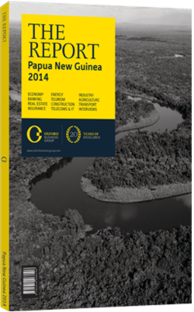Increasing penetration through microinsurance products
With 94% of non-life (non-compulsory third-party motor cover) premiums stemming from corporates and the lion’s share of life coming from group policies, the scope for expanding insurance penetration in the market is vast. Yet with GDP per capita of $2200 in 2013, according to Standard & Poor’s, scaling products down will be key to driving volume and premium growth. While the government is focusing on micro-bank products in its financial inclusion strategy, the bundling of microinsurance with credit products has potential to drive wider retail insurance adoption. A micro-life policy by Pacific MMI (PMMI) rolled out in 2012 is structured as a limited term-life cover sold bundled through the leading microfinance bank’s mobile platform.
Financial Inclusion
Launched in December 2013, the Bank of Papua New Guinea’s (BPNG) two-year National Financial Inclusion and Financial Literacy Strategy builds on the Pacific Financial Inclusion Programme (PFIP) backed by $5.3m in funding from UN Development Programme, the UN Capital Development Fund, AusAID and the EU over four years to 2013. Having already licensed five mobile banking services since 2011, with a total of some 360,000 registered users by late 2013, BPNG aims to add 1m previously unbanked clients – 50% women – to the market by 2015 (see Banking chapter). As the life insurance regulator, BPNG has also benefitted from technical assistance from the Pacific Financial Inclusion Programme (PFIP) in building up its supervisory capacity and knowledge of microinsurance. PNG is one of three countries in Oceania, alongside Fiji and Timor-Leste, to have piloted a microinsurance scheme, according to MunichRe.
One of the key challenges is identifying groups of people, either associations such as oil palm growers, microfinance institutions or clients of a particular service, through which to sell the policies. Containing distribution and operational costs such as claims processing is key to the success of policies with such low margins.
While the Life Insurance Corporation, affiliated with National Teachers Insurance, had launched a low-cost funeral policy in 2008, it has struggled to appeal to microfinance institutions and savings and loans societies to distribute it, according to PFIP research.
MiLife
In April 2013 Nationwide Microbank (NMB), PNG’s largest microfinance institution, which is backed by AusAID, the Asian Development Bank and the UN and had assets of PGK70.98m ($28.9m) and 125,000 depositors in 2012, launched a pilot microinsurance product – and the Pacific’s first mobile microinsurance scheme – in Lihir. Underwritten by PMMI and supported by the PFIP, the MiLife term-life policy provides funeral cover in the event of accidental or natural death (excluding HIV/AIDS) and is bundled with NMB’s mobile banking service, MiCash. Covering policyholders aged 18 to 60 and their spouse, the policy costs PGK55 ($22) a year and provides pay-outs of PGK5000 ($2033).
Funerals in PNG are typically expensive and often result in the family of the deceased incurring debt. With the quick payment of claims crucial to the scheme’s success, PMMI and NMB seek to process claims within five working days following the completion of documentation, crediting the MiCash account of the policyholder’s spouse.
Claims under the scheme are appraised by local NMB staff, reducing processing times. NMB signed up 30 MiCash clients in Lihir in the first two months, and it expects to roll out the scheme to other provinces in 2014. The pilot project has been closely followed by other microfinance banks, such as PNG Microfinance and the National Development Bank’s People’s MicroBank, mobile financial service providers like Digicel as well as BSP, which already operates a successful rural banking programme.
While the bundling of life insurance with transaction banking or credit products offers much potential, insurers are also looking at possible applications in non-life, such as comprehensive motor cover. Although it is still in its pilot phase, the scaling up of microinsurance through a low-cost mobile banking platform in PNG could offer lessons for other low-income markets.
You have reached the limit of premium articles you can view for free.
Choose from the options below to purchase print or digital editions of our Reports. You can also purchase a website subscription giving you unlimited access to all of our Reports online for 12 months.
If you have already purchased this Report or have a website subscription, please login to continue.

